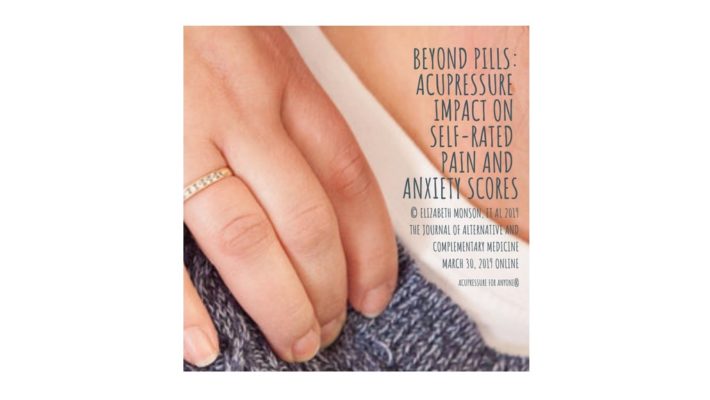
New Study – Beyond Pills: Acupressure Impact on Self-Rated Pain and Anxiety Scores
By Deanna Waggy, OTR
There is increasing need for treatment options that provide relief from common symptoms such as pain and anxiety, which are efficacious and safe. The health care system is also facing a crisis of pills, opioid, and otherwise, which can increase risk of tolerance, addiction, abuse, and death. Use of effective nonpharmacologic options is now mandated by Joint Commission Guidelines per updated pain management recommendations January 1, 2018.
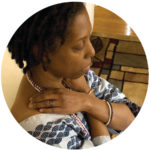
A recent study compared an opioid versus non-opioid medications for treatment of chronic pain over a 12-month period, and found that using non-opioid therapies offered lower pain scores over time as compared with the opioid therapy group. Extrapolating from this research, a stronger pain pill is not the most effective way to manage chronic pain. Integrative therapies expand treatment options, thereby offering hope to address symptom management without increased risk of adverse effects.
There is growing interest in the use of acupressure as an alternative to opioid and non-opioid medication. A new multi-disciplinary study shows how nurses, massage therapists and occupational therapists can use a simple 16 step stress relief acupressure protocol in a variety of settings to reduce pain and anxiety. Acupressure, an older form of acupuncture, does not require the use of needles but uses gentle finger pressure on the same points to treat various conditions and improve well-being.
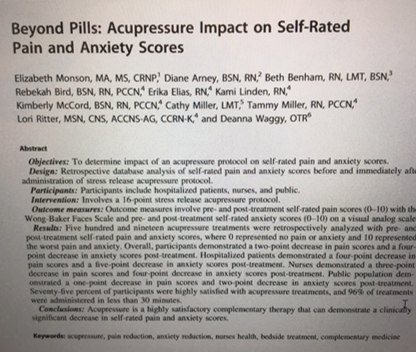
Beyond Pills: Acupressure Impact on Self-Rated Pain and Anxiety Scores was recently published online in the Journal of Alternative and Complementary Medicine. This retrospective quality improvement database analysis of self-rated pain and anxiety scores before and immediately after administration of stress release acupressure protocol was conducted over a 7 year period.
The sample size of 519 participants from 6 different states included treatments administered by a nurse, licensed massage therapist or occupational therapist trained in a single 16-point acupressure protocol through at least 6 hours of training on how to administer the protocol. Individuals voluntarily elected to receive or self-administer through guided demonstration, the Seva Stress Release Acupressure protocol in a hospital or public setting.
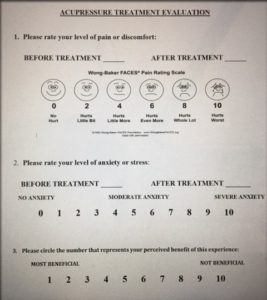
Participants used the Wong-Baker Faces Scale to record or rate their level of pain verbally or through worksheet before and immediately after receiving acupressure treatment, with 0 representing no pain and 10 representing the highest level of pain. Participants were also invited to self-report their level of anxiety before and immediately after receiving acupressure treatment using a 0–10 visual analog scale, with 0 indicating no anxiety and 10 indicating extreme levels of anxiety.
In all populations, pain and anxiety scores decreased, a finding that was both statistically and clinically significant. There was a greater decrease in pain and anxiety scores when treatments were administered by a trained registered nurse, licensed massage therapist or occupational therapist as compared with the intervention being guided and self-administered by participants. There were no reported adverse events with any of the treatments. Treatments were performed in <30 min, and many were performed in <15 min, equivalent to or less than the onset of action for most pharmacologic agents. Overall, these treatments were rated with the highest level of satisfaction by three quarters of participants.

Overall, participants demonstrated a two-point decrease in pain scores and a four-point decrease in anxiety scores post-treatment. Hospitalized patients demonstrated a four-point decrease in pain scores and a five-point decrease in anxiety scores post-treatment. Nurses demonstrated a three-point decrease in pain scores and four-point decrease in anxiety scores post-treatment. Public population demonstrated a one-point decrease in pain scores and two-point decrease in anxiety scores post-treatment. Seventy-five percent of participants were highly satisfied with acupressure treatments, and 96% of treatments were administered in less than 30 minutes.

Present health care systems need additional tools to treat pain and anxiety, which are safe, effective, and avoid the potential for addiction. Health care systems also need cost-effective therapies that can be easily employed in a variety of settings. The health care environment also needs tools that contribute to both patient and provider satisfaction, to improve health and overall wellness outcomes.
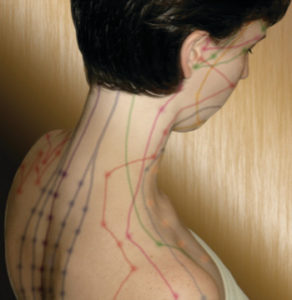
Acupressure is an effective tool to address these escalating health care demands. This retrospective analysis has provided evidence that acupressure is a nonpharmacologic tool that can effectively reduce pain and anxiety without adverse events. This intervention also resulted in a high degree of participant satisfaction.
A prospective RCT with standardized tools comparing acupressure with traditional pharmacologic therapy may shed light on impact and efficaciousness of each therapy. Acupressure is a highly satisfactory complementary therapy that can demonstrate a clinically significant decrease in self-rated pain and anxiety scores, especially when using the 16 step Seva Stress Release Acupressure protocol administered by trained registered nurses, licensed massage therapists and occupational therapists.

Deanna Waggy, OTR has a private wellness practice in South Bend, Indiana as an OT, incorporating a variety of integrative health practices including Process Acupressure and Zero Balancing to empower whole-being health. She teaches Seva Stress Release and Acupressure For Anyone ® classes teaching individuals to take charge of their own health using acupressure. She is the co-author of Empowering Whole-Being Health, with over 80 case reviews using acupressure protocols. She collected data along with several colleagues as an internal quality control study on the Seva Stress Release acupressure protocol, which was used for this retrospective research project. Visit here website here.





Leave a Reply